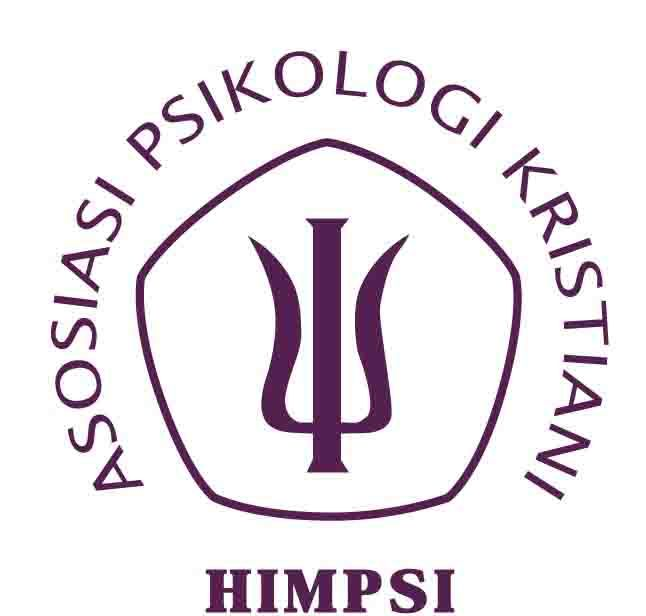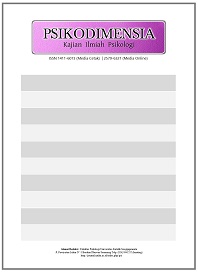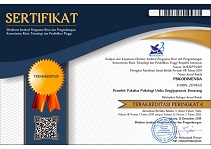Pengembangan Instrumen Ukur Persepsi Guru terhadap Sumber Daya di Sekolah Inklusi Kota Yogyakarta
Abstract
Inklusivitas dalam pendidikan menjadi penting karena berkaitan dengan hak semua individu untuk mendapatkan akses pendidikan yang berkualitas, khususnya untuk kelompok rentan seperti disabilitas. Guru sebagai stakeholder harus memiliki sumber daya yang cukup, baik sumber daya secara fisik maupun personal untuk menunjang kegiatan pembelajaran di sekolah. Mengingat pentingnya persepsi guru terhadap sumber daya dalam pendidikan inklusif, diperlukan instrumen pengukuran yang valid dan reliabel untuk menilai aspek ini. Penelitian ini bertujuan untuk mengadaptasi instrumen Teacher Version of Perception of Resource Questionnaire (PRQ-T) ke dalam bahasa Indonesia. Partisipan dalam penelitian ini adalah guru yang mengajar di sekolah inklusi di Daerah Istimewa Yogyakarta dengan jumlah 18 partisipan untuk uji keterbacaan dan 107 partisipan untuk field testing. Pengambilan data dilakukan secara langsung menggunakan lembar kuesioner. Metode pengembangan skala dilakukan dengan adaptasi meliputi: 1) persiapan, 2) forward translation, 3) sintesis, 4) back-translation, 5) back-translation review, 6) cognitive debriefing, 7) finalisasi, 8) field testing, dan 9) uji psikometrik. Hasil uji normalitas menggunakan Shapiro-Wilk ditemukan bahwa data partisipan tidak normal (p<0,001) sehingga perlu dilakukan CFA menggunakan estimator Diagonally Weighted Least Squares (DWLS). Hasilnya menunjukkan PRQ-T versi bahasa Indonesia memiliki model yang fit untuk model 2 faktor (CFI= 1,000; TLI= 1,002; SRMR=0,078; RMSEA= 0,000).
Keywords
Full Text:
PDF (Bahasa Indonesia)References
Ahmmed, M. (2013). Measuring perceived school support for inclusive education in Bangladesh: the development of a context-specific scale. Asia Pacific Educ. Rev. 14, 337–344. doi: 10.1007/s12564-013-9263-z
Almalki, N., & Abaoud, A. (2015). Association of Children with Disabilities experience in inclusion of children with multiple disabilities in pre-school public schools in Riyadh. International Consulting Group Journal, 4(5), 30–47.
Alnahdi, G. H., Goldan, J., & Schwab, S. (2021). Psychometric Properties and Rasch Validation of the Teachers’ Version of the Perception of Resources Questionnaire. Frontiers in Psychology, 12. https://doi.org/10.3389/fpsyg.2021.633801
Alrayss, T., & Algmeay, W. (2016). Obstacles of the inclusion of deaf and hearing-impaired children in kindergarten from the perspective of their teachers in Saudi Arabia. Journal of Special Education and Rehabilitation, 4(15), 8–38.
Alssissi, A. (2017). A suggested organizational structure for general education schools applicable to the system of inclusion in the Medina city. Scientific Publishing Council, Kuwait University, 52(125), 299-341.
Andriani, A. D., Ardiansyah, M., & Mus, S. (n.d.). PENGELOLAAN PENDIDIKAN INKLUSI DI SEKOLAH QUANTUM BRAIN MAKASSAR.
Arrah, R. O. (2013). Teachers’ Perceptions of Students with Special Education Needs in Cameroon Secondary Schools.
Avramidis, E., & Norwich, B. (2002). Teachers’ attitudes towards integration/inclusion: A review of the literature. In European Journal of Special Needs Education (Vol. 17, Issue 2, pp. 129–147). https://doi.org/10.1080/08856250210129056
Azwar, S. (2014). Metode penelitian. Yogyakarta. Pustaka pelajar.
Azwar, S. (2016). Penyusunan skala psikologi. Yogyakarta: Pustaka Pelajar.
Bahri, S. (2021). Manajemen Pendidikan Inklusi di Sekolah Dasar. EDUKATIF : JURNAL ILMU PENDIDIKAN, 4(1), 94–100. https://doi.org/10.31004/edukatif.v4i1.1754
Booth, T., Ainscow, M., Black-Hawkins, K., Vaughan, M. and Shaw, L. (2000) Index for Inclusion (Bristol: Centre for Studies on Inclusive Education).
Campos, M. J., J. P. Ferreir, and M. E. Block. (2014). Influence of an Awareness Program on Portuguese Middle and High School Students’ Perceptions of Peers with Disabilities.Psychological Reports, 115(3), 897–912.
Chiner, E., and Cardona, M. C. (2013). Inclusive education in Spain: how do skills, resources, and supports affect regular education teachers’ perceptions of inclusion? Int. J. Inclu. Educ. 17, 526–541. doi: 10.1080/13603116.2012.689864
Damianidou, E., & Phtiaka, H. (2018). Implementing inclusion in disabling settings: The role of teachers’ attitudes and practices. International Journal of Inclusive Education, 22(10), 1078-1092.
Goldan, J., & Schwab, S. (2018). Measuring students’ and teachers’ perceptions of resources in inclusive education: Validation of a newly developed instrument. International Journal of Inclusive Education. https://doi.org/10.1080/13603116.2018.1515270.
Hakeu, F., Djahuno, R., & Zakarina, U. (2023). Transformasi Pembelajaran dalam Pengembangan Model Pendidikan Inklusif Bagi Anak Berkebutuhan Khusus. In Journal of Elementary Educational Research (Vol. 3, Issue 2). http://ejournal.iain-manado.ac.id/index.php/jeer
Hu, L., & Bentler, P. M. (1999). Cutoff criteria for fit indexes in covariance structure analysis: Conventional criteria versus new alternatives. Structural Equation Modeling: A Multidisciplinary Journal, 6(1), 1–55. https://doi.org/10.1080/10705519909540118
Azwar, S. (2017). Metode Penelitian Psikologi (II). Pustaka pelajar.
Juntak, J. N. S., Rynaldi, A., Sukmawati, E., Arafah, M., & Sukomardojo, T. (2023). Mewujudkan Pendidikan Untuk Semua: Studi Implementasi Pendidikan Inklusif di Indonesia. Jurnal Birokrasi & Pemerintahan Daerah, 5(2), 205–214.
Lahesti, E., Raja, M., Haji, A., Akhyary, E., Hendrayady, A., Alamat, A. H., Raya Dompak, J., & Dompak, P. (2023). Implementasi Kebijakan Pendidikan Inklusif : Studi Kasus SMP Negeri 15 Tanjungpinang. 1(3), 250–262. https://doi.org/10.55606/eksekusi.v1i3.534
Maghrabi, M. (2013). Obstacles facing student teacher in the inclusion schools and their impact in their attitudes towards children with intellectual disabilities. Society for Culture for Development Journal, 13(69), 107–180
Muzdalifah, F., & Billah, H. Z. (2017). Pengaruh efikasi pada sikap guru terhadap pendidikan inklusif. Jurnal Penelitian dan Pengukuran Psikologi: JPPP, 6(1), 26-34.
Rahma, A. N. (2023). Optimalisasi Manajemen dalam Penerapan Inklusi Pendidikan di Sekolah Dasar. In JME Jurnal Management Education (Vol. 1).
Rofiah, N. H. (2023). The Progress of Inclusive Education Toward Agenda 2030 in Indonesia. In Progress Toward Agenda 2030, 21, 191-207. Emerald Publishing Limited.
Schneider, K., Klemm, K., Kemper, T., & Goldan, J. (2017). Dritter Bericht zur Evaluation des Gesetzes zur Förderung kommunaler Aufwendungen für die schulische Inklusion in Nordrhein-Westfalen. www.wib.uni-wuppertal.de
Schwab, S., Alnahdi, G., Goldan, J., & Elhadi, A. (2020). Assessing perceptions of resources and inclusive teaching practices: A cross-country study between German and Saudi students in inclusive schools. Studies in Educational Evaluation, 65. https://doi.org/10.1016/j.stueduc.2020.100849
Vanderpuye, I., Obosu, G. K., & Nishimuko, M. (2018). Sustainability of inclusive education in Ghana: teachers’ attitude, perception of resources needed and perception of possible impact on pupils. International Journal of Inclusive Education, 1–13. doi:10.1080/13603116.2018.1544299
Vorapanya, S., & Dunlap, D. (2014). Inclusive education in Thailand: Practices and challenges. International Journal of Inclusive Education,18(10), 1014–1028.
Wicklin, R. (2022, April 25). On Bartlett’s sphericity test for correlation - The DO Loop. The DO Loop. https://blogs.sas.com/content/iml/2022/04/27/bartletts-sphericity-test.html#:~:text=Bartlett's%20sphericity%20test%20provides%20information,components%20or%20common%20factor%20analysis
Wild, D., Grove, A., Martin, M., Eremenco, S., McElroy, S., Verjee-Lorenz, A., & Erikson, P. (2005). Principles of Good Practice for the Translation and Cultural Adaptation Process for Patient-Reported Outcomes (PRO) Measures: Report of the ISPOR Task Force for Translation and Cultural Adaptation Background and Rationale. http://www.ispor.org
DOI: https://doi.org/10.24167/psidim.v23i2.12479
Print ISSN : 1411-6073 | online ISSN : 2579-6321 View My Stats

This work is licensed under a Creative Commons Attribution 4.0 International License.




















